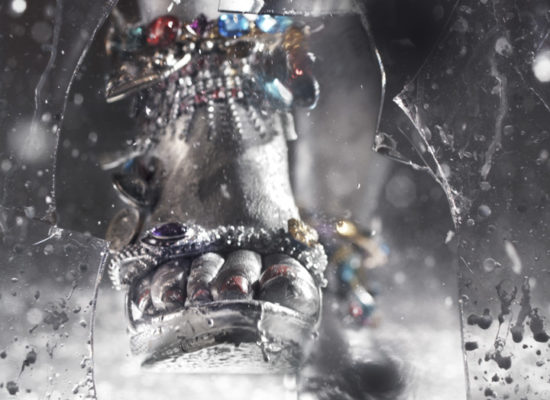“Killer Heels: The Art of the High-Heeled Shoe” opened this week at the Brooklyn Museum, and while it’s predictably a fashion lover’s paradise, Carrie Bradshaw disciples aren’t the only ones who will get a kick out of it. Broken into six thematic sections, including “Architecture,” “Metamorphosis,” and “Glamour and Fetish,” the show is unexpectedly thought provoking, thanks in no small part to video contributions from Ghada Amer and Reza Farkhondeh, Zach Gold, Steven Klein, Nick Knight, Marilyn Minter, and Rashaad Newsome, which were commissioned specifically for the exhibition (see “VIDEO: Rashaad Newsome and Louboutin Lace Up at the Brooklyn Museum“).
The films are as different as the artists themselves, and range from Newsome’s dizzying, kaleidoscopic celebration of all things red-soled and five inches high, to Knight’s hard-to-watch footage of women painfully jamming their feet into clear plastic shoes (seriously, beware: your feet will have sympathy pains). Newsome’s The Knot also breaks ground by showing how gay men have adopted the iconography of heels, further complicating their symbolism. But the exhibition’s best videos fall somewhere in between Newsome and Knight’s extremes of pleasure and pain.
Klein’s Untitled subverts the oft-repeated notion that high heels are torture chambers invented by men to make it more difficult for women to flee. The piece opens with a shot of a faceless woman in eight-inch, lucite-bottomed monsters walking on the smooth chest of a shirtless man who lies helpless beneath her. Two other pairs of shoes are then used to smash to bits a toy car and scratch the shiny red finish off a real one. Whoever Klein’s mysterious protagonist is, she has a fierce shoe closet and an appetite for male suffering. Guess which thematic section this video fell into? If you guessed “Glamour and Fetish,” you are correct.
Minter’s work transmits the same message of female empowerment via great footwear in a slightly subtler way. Her visually stunning short, Smash, shows bejeweled feet in heels and thick, Scott Campbell-tattooed legs kicking and splashing in a sea of silver paint that explodes into weighty beads that hang suspended in the air before falling. Finally, the beautiful feet grow tired of being ogled and kick at the camera, seemingly smashing through its lens and sending glass tumbling toward the viewer in a million shining pieces. Minter’s piece offers a powerful metaphor for thwarting the male gaze while refusing to relinquish the fabulous trappings of femininity.
Farkhondeh and Amer’s Higher Me diplomatically explores the range of opinions women have regarding heels. Alongside hypnotic images of shadowy women in motion are verbal testimonies of how wearing heels makes one feel feminine, powerful, in control, sexy, vulnerable, unstable—often all at once.
More than any other article of clothing, heels are charged with a broad range of symbolic meanings, for both wearers and viewers. The exhibition foregrounds this heterogeneity. Beyond a fashion statement or even a work of art, high heels have become symbols of sexuality, of power and powerlessness, and, ultimately, of idealized womanhood. They encapsulate the expectation that women should embody diametrically opposed facets of femininity—strong yet vulnerable, sexy yet innocent—and do it all while standing on toothpicks.
Video still from Rashaad Newsome, The Knot (2014).
Photo: Courtesy of the Brooklyn Museum.
Is it possible to visit the exhibition and just enjoy looking at the beautiful, sculptural works of wearable art? Sure. There are many (160 to be exact), and they are varied, impressive, and occasionally abstracted to point of being unrecognizable as footwear. Art and architecture buffs will chuckle at seeing names like Damien Hirst, Zaha Hadid, and Rem Koolhaas among the mix. Avid followers of runway fashion will enjoy seeing past season standouts like Prada’s Spring/Summer 2012 flame sandals in person.
But the opportunity to bring these artists together while considering the meanings and implications of something as ostensibly simple as a shoe is the real treat here. In the end, I left with more questions than I had upon entry: What are these crazy things and what does it mean that women often simultaneously love and hate wearing them, and have continued to do so for hundreds of years? Can a high-heeled shoe function as a symbol for the unrealistic and dichotomous expectations placed on women today, while still just being a fun accessory for an evening out? Were they invented by men to make it harder for women to run away? For an exhibition about footwear, I was pleasantly surprised by the amount of time I spent using my head.
“Killer Heels: The Art of the High-Heeled Shoe” continues at the Brooklyn Museum through February 15, 2015.
